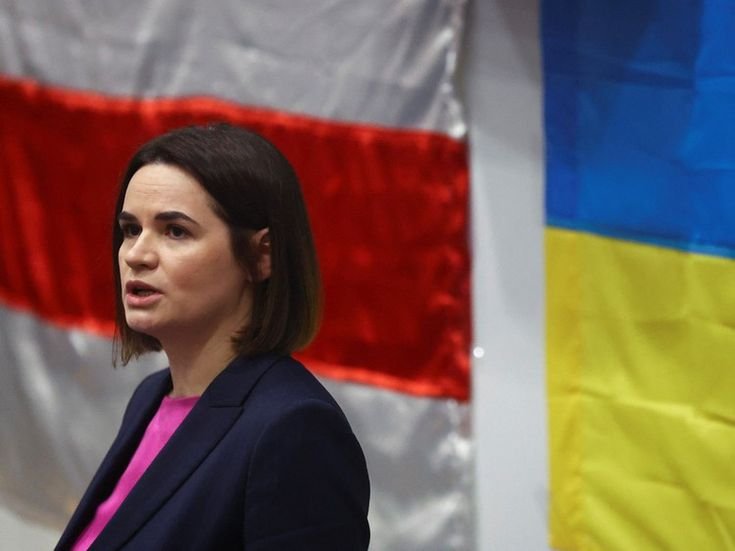Signals of Change or Political Maneuvering?
In a bold and surprising turn, Belarus’s authoritarian ruler has unexpectedly freed a prominent opposition leader from prison, triggering widespread speculation about the nation’s political direction. The historic announcement came amid mounting internal unrest, international pressure, and regional transformation, fueling debate over whether this marks a genuine liberal pivot or a calculated move to rebalance power.
The Sudden Release
On a crisp morning, Belarusian state television broke the news: the opposition figure, long incarcerated on charges of incitement and treason, had been granted immediate release. She exited the prison gates to a throng of supporters, journalists, and thrumming cameras. Dressed in a crisp coat, she paused at the gate, appearing composed yet visibly emotional—hands folded, then opened in acknowledgment of the cheering crowd.
Her release followed a closed-door presidential decree that offered a pardon, citing “exceptional circumstances” and the desire to advance national reconciliation. Despite operating through state channels, the announcement stunned many, given the leader’s high-profile activism and repeated convictions dating back years to large-scale street protests.
The Political Context
A Simmering Protest Movement
Belarus has simmered with unrest since the disputed presidential election years ago. Mass detentions, surveillance, and media crackdowns followed widespread allegations of electoral fraud. The pardoned leader, a vocal critic of the ruling regime, organized rallies, met with embattled voters, and challenged official results—actions that repeatedly placed her behind bars.
International Pressure
Western powers imposed multiple rounds of sanctions on Belarusian officials, state agencies, and businesses, condemning rights violations, electoral interference, and suppression of free speech. Diplomats have continuously urged Belarus to release political prisoners and restore democratic norms. Some analysts suggest the release is timed to ease sanctions and re-engage in diplomacy.
Shifting Regional Tides
Neighboring Ukraine’s defiance against external aggression has emboldened pro-democracy voices. The fall of authoritarian regimes in nearby nations has transformed Eastern Europe’s political landscape. With growing attention on the region, the Belarusian leadership may be attempting to present a softer face, hoping to avoid international isolation and cultivate better ties with Europe.
The Opposition Leader: Profile in Courage
Rising from a humble background, this leader emerged through grassroots civic initiatives, advocating for educational reforms and human rights. She shot into national prominence at the height of protest season, carrying a simple white-red-white flag that became a unifying symbol. Social media and foreign outlets helped amplify her voice, crowning her a symbol of freedom.
Since her first arrest, she spent multiple stints behind bars, and tragically, one of her closest advisors died under questionable circumstances while in state custody. Despite intimidation, she remained resolute—delivering stirring speeches from prison, sketching letters to supporters, and rallying morale among pro-democracy circles.
Her release, therefore, is not just a legal turnaround—it’s a psychological milestone for a movement long driven underground by repression.
Reactions and Ripple Effects
Opposition Unity and Cautious Optimism
Within democratic circles, jubilation erupted. Crowds gathered in rain and sunshine outside her residence, leaders hugged and spoke of unity. Demonstrations swell with renewed purpose as activists channel energy into registering new civic projects, collecting signatures for political reform, and planning future rallies.
Still, there is caution. Some activists fear the release is a carefully orchestrated government performance. They suspect the leader may be under surveillance, her movements monitored, and her speech controlled. For now, she insists her freedom entails no strings—but skeptics remain wary.
Government Messaging
In state media narratives, the decision is billed as magnanimous—a gesture aimed at “national healing.” Senior officials frame her as a “misguided patriot” now ready to contribute constructively. The message walks a careful line: displaying openness while reasserting control. Official statements emphasize that legal boundaries remain firm—another offense would lead to immediate imprisonment.
International Community
Diplomats from the U.S., EU, and neighboring countries have reacted with cautious optimism. A flurry of congratulatory messages underscores support for political pluralism. Some see an opportunity to reopen dialogue on trade and migration. Yet, Western capitals have also warned against premature normalization, stating sanctions remain until systemic reforms follow release of all political prisoners and credible elections.
What This Could Mean Politically
Testing the Waters
Analysts believe the release may be a strategic test to assess public sentiment. Minsk may allow a narrow window for public political activity—to watch whether moderate reforms help ease domestic pressures and improve international standing. A managed release could be a warning: superficial liberalization is permissible, but fundamental power-sharing remains off-limits.
Controlled Liberalization
Some see signals of a managed opening. Smaller civil society organizations are reportedly gaining limited space to operate. Media guidelines appear less strict. Senior civil servants have begun public consultations on incremental reforms. While genuine change is uncertain, controlled liberalization could grant the regime legitimacy without ceding real power.
Symbolism and Risk
By freeing a high-profile activist, the regime acknowledges democratic aspirations without committing to them. It signals readiness to tweak policies but draws lines against larger threats. Yet the move could embolden opposition forces at street level, increasing tension over what “released” freedoms actually entail.
Challenges for the Opposition
Security & Surveillance
Released activists soak up freedom with caution. They receive messages that cameras still record their movement and security services monitor their homes. Requests for large public gatherings are denied, and social media platforms remain restricted. The leader now faces the challenge of balancing public engagement with personal safety.
Fragmentation Risk
Different opposition factions vary in strategy. Some favor immediate push for elections; others support gradual reform within the system. These differences could splinter unity. Ideological and generational divisions may emerge under pressure to define political direction post-release.
Building Viable Platforms
Reintegrating into legal political activity requires building credible base support after years of repression. Official recognition of new parties faces hurdles. Grassroots funding, volunteer coordination, and messaging strategy must be developed rapidly—but government scrutiny remains intense.
Regional Ramifications
Eastern European Watchfulness
Neighboring countries like Lithuania, Latvia, and Poland are closely observing Belarus. A stable shift toward pluralism could ease anxiety in border communities. Civil projects linking Belarusian and Baltic organizations could resume. But should reforms stall, these countries reaffirm strategic support for independent Belarus and strengthen cooperation on security.
Russia’s Reaction
Russia is arguably most affected. As Belarus moves momentarily toward liberalism, Moscow recalibrates. Support for democratic engineering may strain ties. Russia could pressure Minsk to avoid democratic drift—or deepen its security integration. Putin’s cadres are watching for signs of a Belarusian pivot away from Moscow.
European Alignment
EU officials see this as a moment of opportunity: new diplomatic engagement, targeted support for reformers, and possible exemptions on select sanctions. But the EU’s patience relies on measurable action: dissolution of hardline censorship, release of all political prisoners, and real media freedoms.
Risks of Reversal
Crackdown Return
A concern across observers is that this release could mark a transient thaw. Authorities still control the judiciary, Smersh-style secret police, and security forces. Should protests resume, another wave of detentions may follow—reintroducing an atmosphere of fear and hollowing out public trust.
Symbolism Over Substance
Without ongoing reforms, symbolic release risks being dismissed as a calculated public relations move. The real test lies ahead: formation of election commissions, legal freedom to run campaigns, and creation of mechanisms to hold leadership accountable.
Disillusionment & Fracture
The opposition risks burnout. Some activists may lose faith in incrementalism, pushing for confrontation. Others could argue that this is the moment to compromise—accept small wins now in pursuit of bigger change later. This strategic schism may weaken cohesion.
The Road Ahead
Short-Term Signals
The next weeks will be pivotal. Will the released leader speak freely? Will she hold rallies? Will new groups form and register? Watch for emerging legal contests—party registration filings, petition campaigns, policy proposals on health, education, economy.
Mid-Term Strategy
A credible middle path could involve state-authorized civic elections, monitored media reforms, and phased release of other prisoners. Politicians and NGOs will test whether administrative barriers ease. Concord between opposition factions will be key—will they cooperate under a unified agenda or fracture under ambition?
Long-Term Reckoning
In several years, real evaluation begins. Will Belarus hold competitive elections? Will parliament include pro-reform representatives? Will Minsk engage with the EU via trade and migration agreements? Will Russia’s grip loosen? Only sustained reform will answer these.
Symbolic Weight for the Nation
Belarus has long been frozen in time: streets lined with pro-regime billboards, school texts lauding the strong leader, media echoing official narratives. In this environment, moments of public assertion—fist raises, slogans, an electoral petition drive—carry immense symbolic power.
A freed opposition icon is now a living symbol of potential change: courage, ideals, defiance. For young Belarusians, it serves as a reminder that agency and protest aren’t dead. Artists, teachers, and public intellectuals watch closely: Will they find space again to contribute?
Broader Lessons for Authoritarian States
Belarus’s move may influence authoritarian leaders globally: some may launch partial liberalization to stave off revolt. Others may double down, afraid of appears showing cracks in authority. The pattern matters: included voices, staged release, then closure; or incremental space leading to eventual opening.
For democracy advocates, the lesson is that change is often slow, subtle, and politically expensive. Friendliness from the president may open a door, but the walls are still controlled. The balance between hope and realism becomes a daily struggle.
Final Reflections
The release of a leading opposition figure from prison in Belarus marks a profound moment—one loaded with promise, danger, and uncertainty. It offers a potential inflection point for a nation long trapped in authoritarian stasis. It also puts enormous pressure on a movement that must converge on tactics, timing, and unity to truly capitalize on an opening.
For now, the streets of Minsk, Grodno, Gomel, and beyond have their eyes opened. The walls of authority may be porous—but before walls crumble, the cracks must widen. Will Belarus build bridges, or repair its barricades? That question lingers in the hearts of its citizens—as they await the next chapter.


